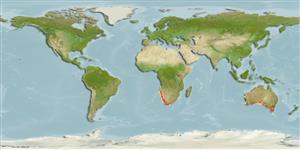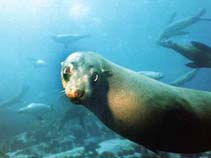Arctocephalus pusillus (Schreber, 1775)
South African fur seal| Native range | All suitable habitat | Point map | Year 2050 |

|
| This map was computer-generated and has not yet been reviewed. |
| Arctocephalus pusillus AquaMaps Data sources: GBIF OBIS |
Classification / Names Common names | Synonyms | CoL | ITIS | WoRMS
Mammalia | Carnivora | Otariidae
Environment: milieu / climate zone / depth range / distribution range Ecology
Bathydemersal; depth range 200 - 200 m (Ref. 1394). Temperate; 0°N - 90°S, 0°W - 160°E
Distribution Countries | FAO areas | Ecosystems | Occurrences | Introductions
Southeast Atlantic: Angola to South Africa. Southeast Indian Ocean and Southwest Pacific: South Central and West Australia.
Length at first maturity / Size / Weight / Age
Maturity: Lm ? range ? - ? cm Max length : 230 cm TL male/unsexed; (Ref. 1394); 180 cm TL (female); max. published weight: 360.0 kg (Ref. 1394); max. published weight: 360.0 kg
Found 160 km offshore. Feeds on a wide variety of prey, including pelagic, mid-water, and benthic animals, such as schooling and solitary fish, cephalopods, and crustaceans. Found 160 km offshore. Feeds on a wide variety of prey, including pelagic, mid-water, and benthic animals, such as schooling and solitary fish, cephalopods, and crustaceans (Ref. 1394).
Life cycle and mating behavior Maturity | Reproduction | Spawning | Eggs | Fecundity | Larvae
Main reference
References | Coordinator | Collaborators
Jefferson, T.A., S. Leatherwood and M.A. Webber. 1993. (Ref. 1394)
IUCN Red List Status (Ref. 130435)
Least Concern (LC) ; Date assessed: 02 March 2015
CITES status (Ref. 108899)
Appendix II: International trade monitored
CMS (Ref. 116361)
Not Evaluated
Threat to humans
Human uses
Fisheries: commercial
FAO - Fisheries: landings, species profile | FishSource |
Tools
More information
Internet sources
BHL | BOLD Systems | CISTI | DiscoverLife | FAO(Fisheries: species profile; publication : search) | Fishipedia | GenBank (genome, nucleotide) | GloBI | Gomexsi | Google Books | Google Scholar | Google | PubMed | Tree of Life | Wikipedia (Go, Search) | Zoological Record
Estimates based on models
Preferred temperature
(Ref. 115969): 11.4 - 20.8, mean 16.1 (based on 574 cells).
Resilience
(Ref. 69278):
High, minimum population doubling time less than 15 months (K=0.3-0.36).
Price category
(Ref. 80766):
Unknown.



